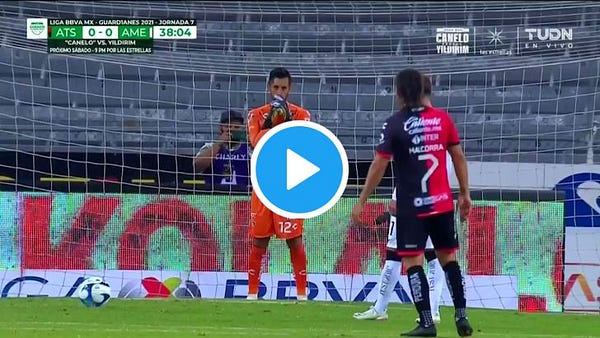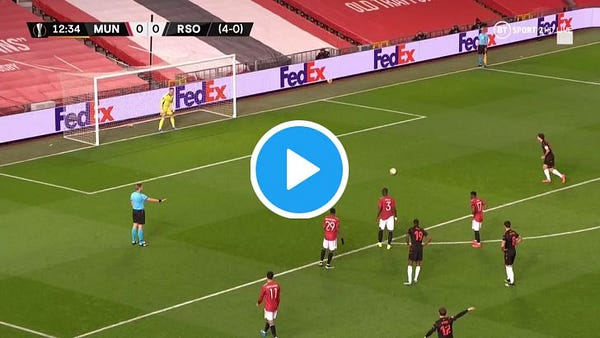The two-touch penalty is back!
The rows and myths, from Blanchflower & Cruyff to Pires & Neymar
Last weekend, Henry Martin scored for Club America in their 2-0 win over Guadalajara in the Mexican league. Martin’s goal was the lesser-spotted two-touch penalty, when the kicker, in this case Sebastian Cordova, rolls the ball gently forward, allowing a team-mate to score from close range. It’s a risky strategy, and it has caused controversy, arguments and some embarrassment along the way.
Image: Cordova (nearest ball) rolls the ball for Martin (to his left) to smash home
Martin looked proud of himself after the game, posting on his Instagram page the message: “You have to dare more and think less!”
His team-mate, Sebastian Cordova, was just as proud. His Insta message read: “The only impossible thing is what you don’t try.”
Here’s the penalty:
This penalty is still relatively rare, so let’s have a look at it in more detail.
Two-touch penalty origins:
Belgian forward Rik Coppens was the first player to score the two-touch penalty. Coppens was one of the best players Belgium ever produced and a true showman: the first Belgian to win the country’s Golden Boot, and a player Barcelona wanted to sign when they missed out on Alfredo di Stefano.
He took the penalty in June 1957 when Belgium was leading Iceland 4-0 in a World Cup qualifier (the final score was 8-3). Coppens said ‘twee tijden,’ to team-mate Andre Pieters, ‘two touches’, hoping he would understand what he meant. Luckily, he did. Here’s the goal:
I interviewed him about this penalty for Twelve Yards. There are two surprising things about it. Firstly, the two players involved had never discussed it before. And secondly, it was actually three touches. Coppens passes to ‘Popeye’ Pieters, he passes the ball back, and Coppens scores.
Coppens explained his thinking to me:
“It was my decision. We were well ahead, so nothing could go wrong. I wanted to do something special for the public. I was a show-off, loved being creative, coming up with something like this was normal for me.”
The Belgian football association was not so pleased with Coppens’s choice of penalty and he was dropped for the return match between the two sides.
Coppens thought penalty-taking was a simple art, even if he did sometimes re-spot the ball four or five times before he was ready to strike. “A penalty is just for technical players,” he added. “I didn't really practise them, but I don't understand how you can miss a penalty. They are so simple.”
But was it really the first?
Thirty-five days before Coppens scored, Northern Ireland played Portugal in a World Cup qualifier at Windsor Park. It was May 1, 1957, and Danny Blanchflower rolled the ball for Jimmy McIlroy to score with a two-touch penalty. You can see it here:
There is some debate as to whose idea the penalty was. Evan Marshall, author of Spirit of 58, believes the idea came from Northern Ireland coach Peter Doherty, an innovative leader who was one of Bill Shankly’s heroes. Ronnie Hanna, author of The World at their Feet quotes McIlroy telling the Belfast Telegraph that their manager was ‘petrified’ at the thought of such a move.
Either way, the penalty was not allowed. It did not count! Some think the referee panicked and ordered a retake because he didn't know what to do. But the footage shows that McIlroy had just encroached into the area before Blanchflower touched the ball. McIlroy scored from the retake to wrap up a 3-0 win.
So McIlroy’s two-touch penalty is the first we have footage of. But Coppens’s penalty was the first that counted. Marshall thinks that Doherty, the team coach, might have taken one in 1945 with his Derby County team-mate Raich Carter. If there are any Derby historians out there, please let us know!
The Cruyff myth
Many people think Johan Cruyff invented the two-touch penalty because of his effort for Ajax with Jesper Olsen against Helmond Sport in 1982. Had Cruyff copied Coppens (not McIlroy – as Olsen returned the pass for Cruyff to score)? He was ten years old when the Iceland game took place, and had been a professional for 19 years before he tried it. It seems unlikely; even so, Coppens was not happy when Cruyff called it ‘unique’. “I didn't like that, Johan Cruyff shouldn't have said that,” he said.
This penalty has been quoted as evidence that Cruyff was a penalty great, but in fact the opposite was true. He hated penalty-kicks, both for aesthetic and technical reasons, and he was no good at them - hence this two-touch strategy. Cruyff’s attitude towards penalties was so powerful that it has informed much of Holland’s penalty trauma since (we’ll explore that in a future edition).
When the two-touch doesn’t work:
In 2005, Arsenal’s Robert Pires tried to reprise the two-touch penalty. Arsenal were leading Manchester City 1-0, ironically through a Pires penalty. The day before the game, Henry had persuaded Pires to try the routine at the end of a training match. Significantly, Henry took the first touch and Pires ran on to score. “Never in a million years did I think we’d be doing the same thing the next day,” Pires told me.
Ten minutes after the first penalty, Arsenal won another. Pires explained what happened against City, and how he succumbed to peer pressure from his compatriot.
“Titi came up to me and said, ‘Okay, we’ll do our special.’ I said, ‘You’ve got to be joking! Not in a real match! But he said, ‘Come on, yeah, yeah, yeah, this is the time to do it, we’re winning.’ I really didn't want to do it but he convinced me.”
The problem, Pires said, was that they had reversed the roles. Pires had received the pass in training, and was now expected to make the pass. “I can tell you, in my head things were not going very well. I said: ‘We shouldn't do it.’ The last thing he said was, ‘Don't worry, I’ll be there.’”
Pires puts the ball on the spot and looks behind him. Henry is stuck behind two City players. As he said:
“Now I’m even more in two minds: should I do it or not? Okay: I do my run-up, stand in front of the ball and in all honesty from then on it's a total black-out. I still can’t see what I did. Everything went black. My foot went over the top of the ball, I don't think I even touched it, then I see Titi next to me saying, ‘What are you doing?’ I felt so stupid.”
When the two-touch does work:
In 2016, in a match between Barcelona and Celta Vigo, Lionel Messi rolled the ball from the penalty spot and Luis Suarez smashed the ball in. The two-touch penalty had worked – except Messi’s pass was not meant for Suarez. Neymar told ESPN after the game: “It was for me, we had practiced it in training! Leo and myself had practiced but Luis was closer and he scored it. It doesn't matter who scores the goals just that we win the games.” Barcelona won 6-1, so no harm done. Celta coach Eduardo Berizzo was asked if his team felt disrespected by the penalty and he replied with a firm no. As he put it: "The penalty is within the law. I'm more hurt by the goals than how they're scored.”
Neymar got a bit closer to the action when he took a similar penalty for PSG in a friendly match in summer 2020 in a 7-0 win over Waasland-Beveren.
There is no doubt that the two-touch penalty is risky. But we might see more of it in the future. I think it appeals to today’s generation of athletes, who love producing a bit of content that promotes creativity and collaboration and yes, can go viral. It might not become as frequent as the Panenka – but at least now you are all experts in the subject! (And thanks to my friend Joel who alerted me to the Club America penalty!)
PEN PALS
After penalty misses from Marco Reus (twice) and Erling Haaland this season, it was intriguing to see Jadon Sancho step up for Borussia Dortmund this weekend. He made no mistake, opting for GK-Independent method and scoring with a shot to his non-natural side. With a major tournament coming this summer, his penalty ability might come in handy for England.
I was left with two questions after Brighton duo Pascal Gross and Danny Welbeck missed penalties in their controversial defeat at West Brom. The first, after Welbeck jumped on the rebound when his kick came off the post, was how many penalty-kickers know the rule that they cannot be the next player to touch the ball after the penalty has been struck (Welbeck may well have known, and was just running on instinct and frustration). The second, after Gross, Maupay and Welbeck have missed penalties this season – as have Leandro Trossard and Yves Bissouma, in the shoot-out win against Newport – is who should take their next penalty? Let me know your thoughts!
Poor Mikel Oyarzabal is having a penalty wobble. He scored 16 in a row for Real Sociedad before missing from the spot in the penalty shoot-out loss to Barcelona last month. Since then, he scored from the spot against Cadiz but missed last week in the Europa League against Manchester United. His penalty technique has worked pretty well for him in the past - but it still seemed to get the anti-hopping brigade hopping mad.
Please share any penalty thoughts or further questions to me either by commenting below or at @benlyt.
If you enjoyed this post, please spread the word about Twelve Yards and share this with your network. And if you’re new, you can see recent pieces including: why it’s better to aim high than low, the great Ederson penalty debate, an interview with Antonin Panenka, how to define a true Panenka, how to end Antoine Griezmann’s run of five missed penalties in a row, penalty records in empty stadia, and Barcelona’s first shoot-out win in 23 years. Thank you!
Ben Lyttleton is the author of Twelve Yards: The Art and Psychology of the Perfect Penalty











